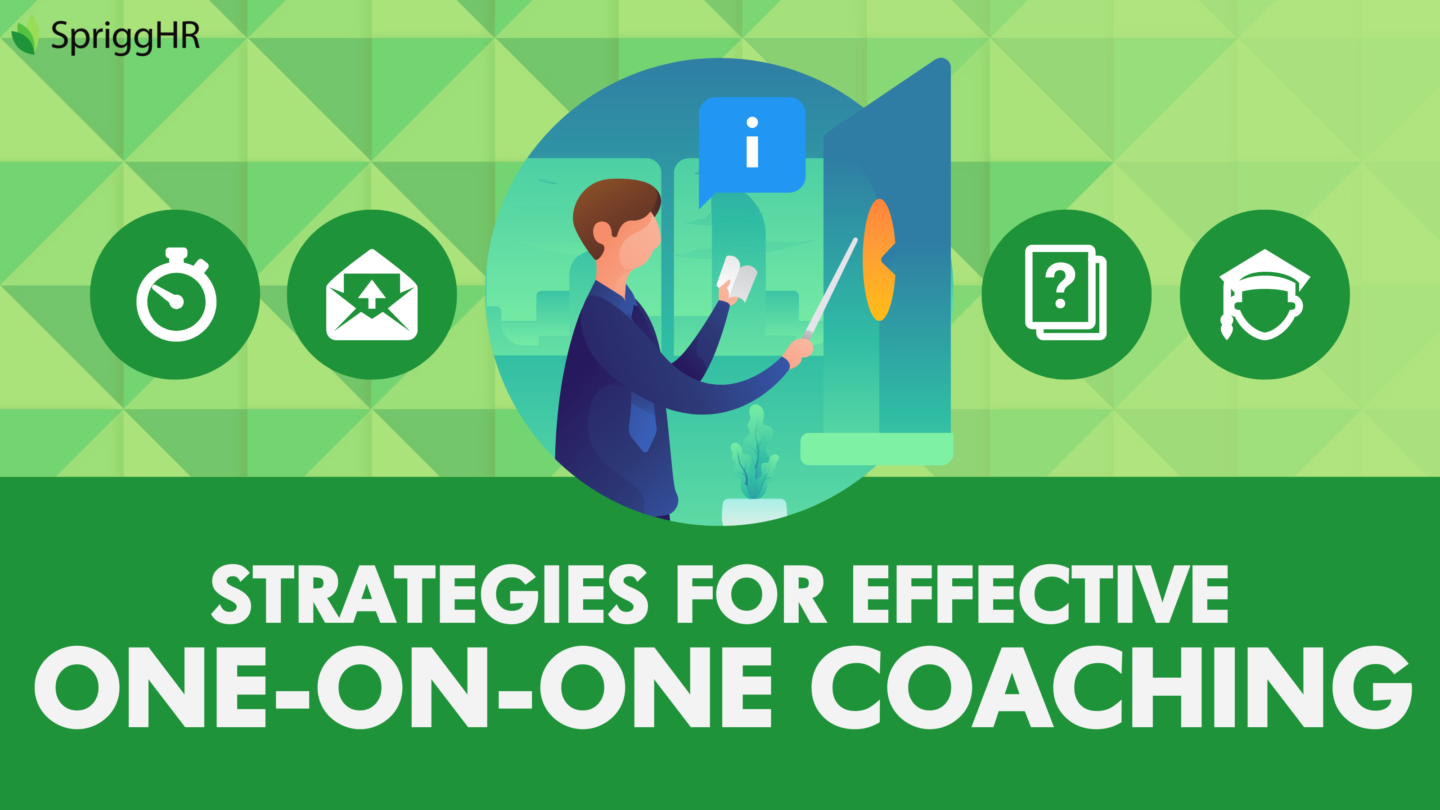
Strategies for Effective One-on-One Coaching
Employee coaching is an integral part of any organization’s communication architecture. A well-designed and implemented coaching model in any business allows for an efficient flow of information and ideas. By implementing consistent one-on-one coaching sessions, you can provide all employees the opportunity to share their ideas, frustrations, and goals within a structured and safe format.
The key to transformational one-on-one coaching sessions lies in keeping the sessions entirely employee focused. While managers can benefit from coaching by asking for feedback on their performance, and suggestions for changes or improvements, the manager’s primary role in coaching sessions is to listen and draw out the key issues and challenges that the employee may be currently facing. As a rule of thumb, a manager should aim to do 80% of the listening, and 20% of the talking.
Benefits of One-on-One Coaching
Running successful one-on-one coaching sessions should always be a priority for managers. A company that places people first and who looks to implement a consistent system of employee-manager communication and employee development sets you apart from other organizations in the market. Successful coaching programs lead to engaged employees who feel supported in their organization, which then works to establish a positive reputation for the work environment of the business.
Structuring Effective One-on-One Coaching Sessions
Frequency & Duration
The frequency and length of coaching sessions are usually left to the manager’s discretion. Therefore, it is advised that you aim to set up one-on-ones on a weekly basis, spending around 30 minutes with each employee. Many managers, and even some employees, tend to view one-on-one sessions as time consuming and futile. The key to changing this perception lies in shifting how you perceive the end-goal of coaching sessions themselves. Managers should view regular private meetings with employees not as an obligation, but rather as necessary check-ins that ensures the alignment of employees’ goals to those of the company. It’s also an ideal time to course-correct any performance-related issues or perhaps address an employee’s questions / concerns.
By consistently checking in on the progress of employees, as well as their individual aspirations within the company, your employees will feel that their contributions to the company are regularly recognized and their motivation to continue to work efficiently will be emboldened. Ensuring employees feel that management cares about their ideas and their career advancement begins with one-on-one coaching. A strong retention rate of high-performing and motivated employees will always be a central goal for leaders in any organization and the execution of these meetings will vastly increase the likelihood of this happening.
Constructive Feedback Sessions
There will always come a time when one-on-one sessions must involve the delivery of constructive feedback for the employee. Talk about the primary issues objectively and be sure to allow them to share their own perspectives to keep the session as an open dialogue, rather than making your own assumptions.
As a leader of the coaching session, it should be your primary goal to move forward in cases like these. Rather than dwelling on the error, spend most of the session focusing on improvements for the future of the employee. Encourage them to develop a plan to remedy the issue and offer support in developing said plan if they are struggling. Wrap up the discussion by scheduling a follow-up session to keep track of their progress and be sure to show enthusiasm with regards to the employee’s goals. Leaving a constructive feedback one-on-one coaching session on a positive note allows for the employee to continue to view the sessions as both productive and positive.
Effective Body Language
Clear communication is an important part of any effective one-on-one coaching session. Non-verbal cues in coaching include adapting your body language to promote the open dialogue you aim to achieve with your employees in each session. Suggestion: try not to separate yourself from the employee by sitting across from them over a conference table. Instead, aim to have an open presence, sitting facing them, keeping your arms uncrossed. This shows you are open and receptive to what they have to say.
The importance of eye contact cannot go unmentioned. By maintaining eye contact, it shows you are actively listening and are genuinely interested in what the employee is saying. Leave your phone off and remove other distractions or interruptions. Not only is this respectful conversation etiquette, but it also promotes the employee’s sense of priority in your day. If you are expecting an important phone call sometime during the meeting, reschedule the session or communicate this expectation at the beginning of the conversation.
Another method you can employ is to take notes throughout the meeting. Not only can this be useful in follow-up sessions when recalling the important points of the conversation, but it is also another way to show the employee you are actively listening and engaged in the discussion.

Strategies for One-on-One Coaching Sessions
Set Clear Goals
The start of any effective coaching relationship lays the foundation for the middle and the end. By communicating the goals of one-on-one sessions from the beginning, it gives both you and your employee a chance to establish what you will work towards in your sessions and sets the tone for what’s to follow in upcoming sessions. To do this, ask as many questions as you can in your introductory session.
An interesting and engaging first session keeps employees’ undivided attention from the start and helps to create a more involved coach-employee relationship. When this first session is also clearly targeting the specific goals of the employee, it allows you to better understand the strategic needs of the individual and helps you to shape your coaching style to promote the employee’s success.
Ask the Right Questions
For any effective coaching session, preparation is key. Before each session, aim to ask yourself key questions to prepare yourself for the session. Examples of these reflective preparatory questions can include, “what are this employee’s key responsibilities?”, “what communication strategies are appropriate for this employee?”, “what am I aiming to do in this session?”. All of these create a defined path for the session. Integrating feedback into the coaching conversation is highly recommended.
To further assist you in preparing for the one-on-one coaching session, try utilizing the format such as “Start, Stop and Continue” – we have prepared some phrases for you:
Start – In order to start leveraging more of your experience and what you’ve learned to date, I would suggest you focus on _____. What do you think?”
Stop – “I think some things that may be getting in your way from optimizing your performance are ___. Does that sound fair or accurate to you?”
Continue – “These are real strengths for you, keep up the great work and focus on continuing to provide this level of input. Where else do you think you excel?”
Other Questions to Consider…
What suggestions do you have for me?
Questions like these helps to keep one-on-one coaching sessions as two-way conversations. Leaders who regularly ask for feedback and focus on improving their own behaviors, as well as the behaviors of employees, are much more likely to have an increase in the effectiveness of their leadership. Employees will always be more open to the idea of being coached when their leaders are also willing to be coached by them.
How can I help?
By listening to and acting upon your employee‘s requests in how it is you can support them, you are building all that’s required for their success. It is here that participation is necessary. For example, you can suggest different approaches to leadership, and ask the employee whether the approach will be helpful in becoming more effective.
Keep Learning
Finally, it should be a central goal for managers to constantly add to and evolve their understanding of the process of coaching and how individual employees react to it. Strong one-on-one coaching systems involve you, as a leader, learning to get your message across effectively. It also requires you to pivot to individual learning styles.
Final Thoughts
The result of effective coaching positively affects employers and employees alike. When a strong one-on-one coaching system is in place, employees will find greater satisfaction in their work efforts, while their ideas and career plans have a vehicle to be discussed.
For employers, one-on-ones provide a clear structure for guidance and focus within your organization, which will overall lead to higher probability to achieving key strategic initiatives and objectives.




